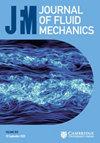高超音速边界层中稳定的局部吹气/吸气的不稳定性和过渡控制
IF 3.9
2区 工程技术
Q1 MECHANICS
引用次数: 0
摘要
系统研究了稳定的大振幅吹/吸对马赫数为 5.86 的高超音速平板边界层的不稳定性和过渡控制的影响。通过直接数值模拟和解析分析,研究了吹吸通量和振幅对不稳定性的影响。当使用相对较小的通量时,区分促进/抑制模式效应的二维不稳定临界频率与同步频率非常接近。对于斜波,随着跨向波数的增加,抑制效应会减弱,在吹气/吸气控制中,模式抑制带宽一般会减小/增大。增加吹吸通量可有效拓宽扰动抑制的频率带宽。在流量恒定的情况下,振幅对干扰抑制的影响较弱。为了更深入地了解扰动抑制机制,我们进一步采用了动量势理论(MPT)和动能预算分析来分析有控制和无控制时的扰动演变。当扰动被抑制时,吹气会诱导某些声学成分沿着压缩波传出边界层,而吸气则不会。速度波动源自 MPT 的动量波动。与动量波动相比,各分量的速度波动所显示的演变过程大大有助于研究二模的声学性质。吹气附近扰动振幅的快速变化是由声学分量的振荡以及涡旋分量和热分量之间的相位速度差异引起的。进行动能预算分析是为了解决吹气/吸气引入的边界层的非平行效应,这种效应往往会抑制吹气附近的扰动。此外,在边界层迅速增厚的区域,导致能量耗散的粘性效应会更强。最后,研究表明,吹气/吸气组合控制可以延迟随机扰动引发的平板边界层过渡。解析分析进一步证明,在受控基流中,频率主导早期过渡阶段的扰动会受到抑制。本文章由计算机程序翻译,如有差异,请以英文原文为准。
Instability and transition control by steady local blowing/suction in a hypersonic boundary layer
The efficacy of steady large-amplitude blowing/suction on instability and transition control for a hypersonic flat plate boundary layer with Mach number 5.86 is investigated systematically. The influence of the blowing/suction flux and amplitude on instability is examined through direct numerical simulation and resolvent analysis. When a relatively small flux is used, the two-dimensional instability critical frequency that distinguishes the promotion/suppression mode effect closely aligns with the synchronisation frequency. For the oblique wave, as the spanwise wavenumber increases, the suppression effects would become weaker and the mode suppression bandwidth diminishes/increases in general in the blowing/suction control. Increasing the blowing/suction flux can effectively broaden the frequency bandwidth of disturbance suppression. The influence of amplitude on disturbance suppression is weak in a scenario of constant flux. To gain a deeper insight into disturbance suppression mechanism, momentum potential theory (MPT) and kinetic energy budget analysis are further employed in analysing disturbance evolution with and without control. When the disturbance is suppressed, the blowing induces the transport of certain acoustic components along the compression wave out of the boundary layer, whereas the suction does not. The velocity fluctuations are derived from the momentum fluctuations of the MPT. Compared with the momentum fluctuations, the evolutions indicated by each component's velocity fluctuations greatly facilitate the investigations of the acoustic nature of the second mode. The rapid variation of disturbance amplitude near the blowing is caused by the oscillations of the acoustic component and phase speed differences between vortical and thermal components. Kinetic energy budget analysis is performed to address the non-parallel effect of the boundary layer introduced by blowing/suction, which tends to suppress disturbances near the blowing. Moreover, viscous effects leading to energy dissipation are identified to be stronger in regions where the boundary layer is rapidly thickening. Finally, it is demonstrated that a flat plate boundary layer transition triggered by a random disturbance can be delayed by a blowing/suction combination control. The resolvent analysis further demonstrates that disturbances with frequencies that dominate the early transition stage are dampened in the controlled base flow.
求助全文
通过发布文献求助,成功后即可免费获取论文全文。
去求助
来源期刊
CiteScore
6.50
自引率
27.00%
发文量
945
审稿时长
5.1 months
期刊介绍:
Journal of Fluid Mechanics is the leading international journal in the field and is essential reading for all those concerned with developments in fluid mechanics. It publishes authoritative articles covering theoretical, computational and experimental investigations of all aspects of the mechanics of fluids. Each issue contains papers on both the fundamental aspects of fluid mechanics, and their applications to other fields such as aeronautics, astrophysics, biology, chemical and mechanical engineering, hydraulics, meteorology, oceanography, geology, acoustics and combustion.

 求助内容:
求助内容: 应助结果提醒方式:
应助结果提醒方式:


